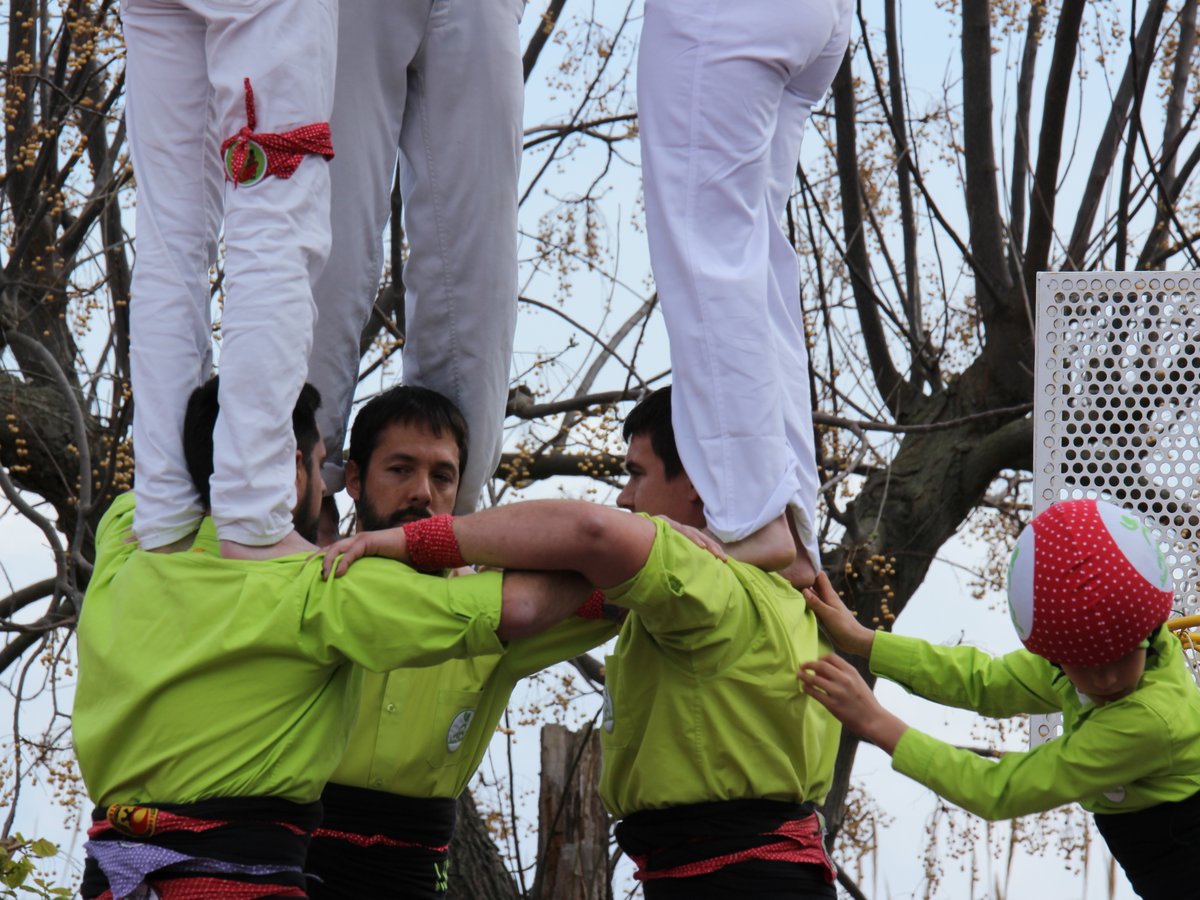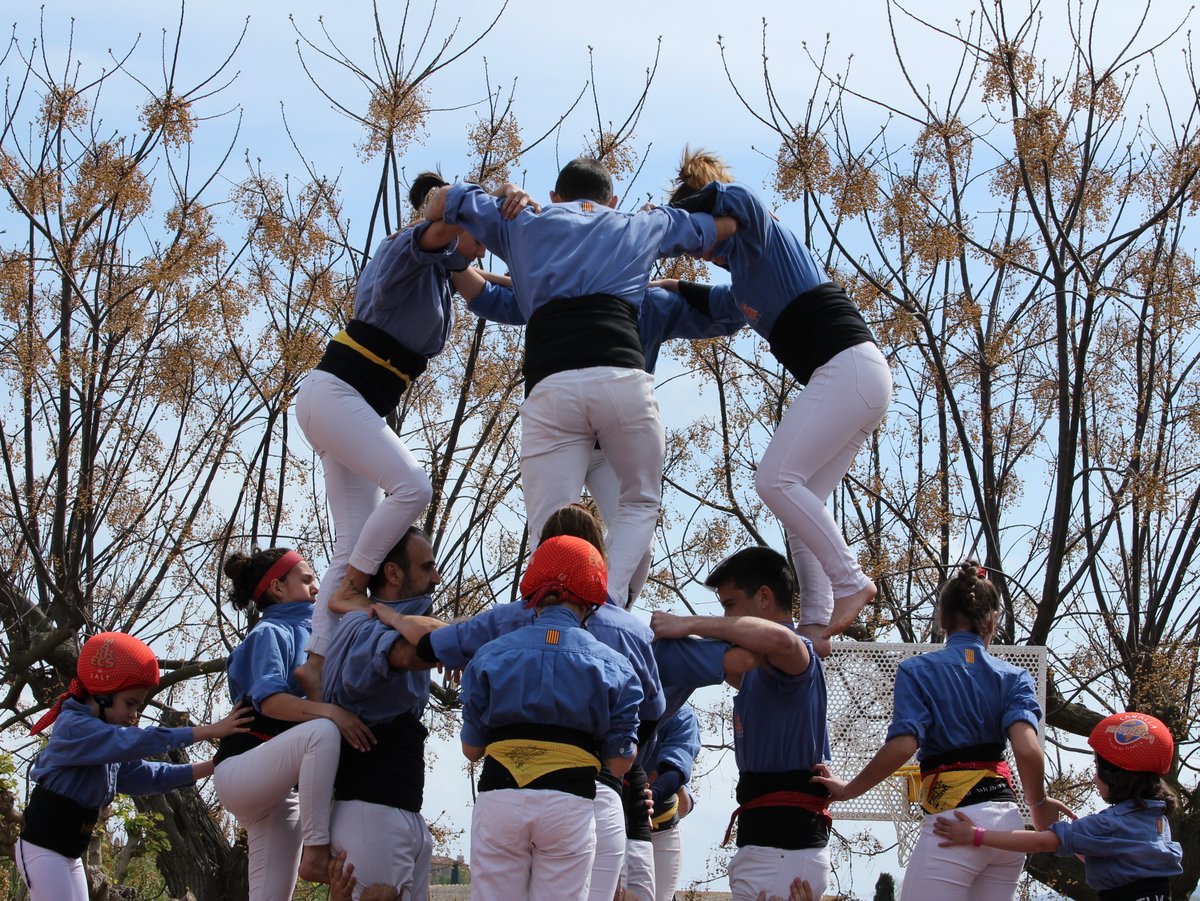If one day you find yourself in the midst of a traditional Catalan fiesta on a central town square somewhere, you are likely to see people in white pants and colourful shirts making elaborate human towers by climbing on each other’s shoulders. Your first thought might be that the circus is in town, but once you see another group of similar-looking people wearing shirts of a different bright colour, you might start wondering. Without knowing, it is impossible to tell that what you see is a truly impressive, a seriously athletic competition for points and trophies, known as castells (“castles”)1, a sports activity and a tradition that is unique to Catalonia.
Who first had an idea to entertain the crowd in such a way is unknown, but most historians agree that it happened in the mid- to late-18th century and was not a standalone thing but rather a closing number of the so-called Valencian dance (ball dels valencians). Before climbing on top of each other’s shoulders, “Valencians” moved around a lot — jumping, twirling in pairs, forming circles… But building human towers as the grand finale seemed to be a more entertaining number. It was also easier to judge in terms of athleticism and mastery of the dance, so the human castle building inevitably turned into a competition — who could build it the tallest — and later became its own separate event.
At the beginning of the 19th century, the town of Valls in Tarragona became a home to the very first colla (“groups”), the clubs uniting lovers of castells. Football had not been invented just yet, the people demanded entertainment, and the performances of castells were not limited by the town boundaries — the neighbouring pueblos were happy to invite experienced teams and even cover their travel expenses. This is how these groups, originally just hobby clubs, started acquiring managers and administrators that would oversee budgets and plan trips. Today, Catalonia has over 80 clubs of castells, each of which customarily has an office and training space, operating with the help of management, accounting, logistics, and IT departments.
The main event in the castells world, the world championship in the human castle building, is Concurs de Castells, organized in Tarragona in even-numbered years and held at the former bullfighting arena in the city. The 42 top-standing clubs from the rating table (updated weekly) are invited to participate. The rating reflects the points scored by each team for the three most complex formations achieved in the top five of the team’s performances in a two-year period.
So how is a human castle assembled, what parts does it include, and why are some parts of the formation scored higher than others?
A good half of the team is involved at the base level of the castle, called pinya (“a tight group, circle”). Here, the foundation for the whole formation is laid out, and if you take a look at the people’s positioning inside the pinya, you will quickly realize that this is the most complex part of the human castle.
Each person in the centre of the pinya has a specific role to play: some offer their shoulders for the upper levels to stand on, others block them from losing balance, yet others push against their knees, hips and buttocks, and so on. Over the two centuries of castells’ existence, parts played by the members of the pinya have evolved into 7 (!) distinct roles: agulles, baixos, contraforts, primeres mans, crosses, vents, laterals.
If the team has set its sights onto a complex multi-level formation, a pinya structure may need to be replicated at the second, third and sometimes even the fourth level of the castle. The reports of the castells performance, in this case, would talk about folre – “lining”, manilles – “cuffs”, and puntals – “braces” or “props”.
Besides forming the base, the pinya also serves as a landing pad for those building up the higher levels. Shoulders and backs of one’s teammates may not be the best thing to land on when falling from up high, but an acceptable one to prevent serious injuries.
Once the base formation is assembled, the tronc (“trunk”) starts growing out of it. This section of the human castle has an identical number of athletes on each level, from one to five depending on what formation is being attempted. For “trunks” of minimal “thickness”, specific terms are used: if each level has only one athlete, it is a pilar (“pillar, column”); if two people are used, it becomes a torre (“tower”).
Any castle except for the column type is crowned by the group of four called poma de dalt (“the top apple”), which adds three points to the total number of levels. Any awkward movement at this height may cause the whole formation to lose balance and collapse, so the weight of the “apple” is generally minimized by recruting the lightest members of the team for the top: two teenagers in a tight hug and two preschool-aged children atop their shoulders.
Once the child at the top raises their hand, or “flaps a wing” (fa l’aleta), the human castle is considered built and may begin to be disassembled, but in an orderly manner with no jumps of falls to be awarded the maximum number of points.
The formula describing the castle formation consists of two digits. For example, 3 de 8 means 3 athletes at each level of the trunk for the total number of 8 levels. For the pillar-type formations, the first digit is replaced by the word pilar — pilar de 6. If extra sections are present between the pinya and the trunk, they are noted after the formula: for example, 3 de 10 con folre y manilles describes a formation with a three-level base that includes the “lining” and the “cuffs”. Sometimes, adjectives are used, like net, limpio (“neat, clean”): seeing 4 de 9 net tells you that the trunk is formed directly on top of the pinya without additional reinforcing levels, indicating the high level of mastery and experience of the castells team.
Certain examples of the castells “architecture” are rare. For example, 2 de 8 limpio, 3 de 10 con folre y manilles, 4 de 9 limpio are on every castells lover’s bucket list, whether they want to witness it as a spectator or to help build it as part of a team.
While theoretically possible, assembling a human castle that would have 11 levels has never been done in more than two hundred years of the castells history. No team has yet attempted to break this record during a tournament2, but who knows — perhaps a club from Valls, Vilafranca or Terrasa is training vigorously at this very moment to one day make the tallest human castle happen.
1 Translation from Catalan
2 As of March 1, 2019






